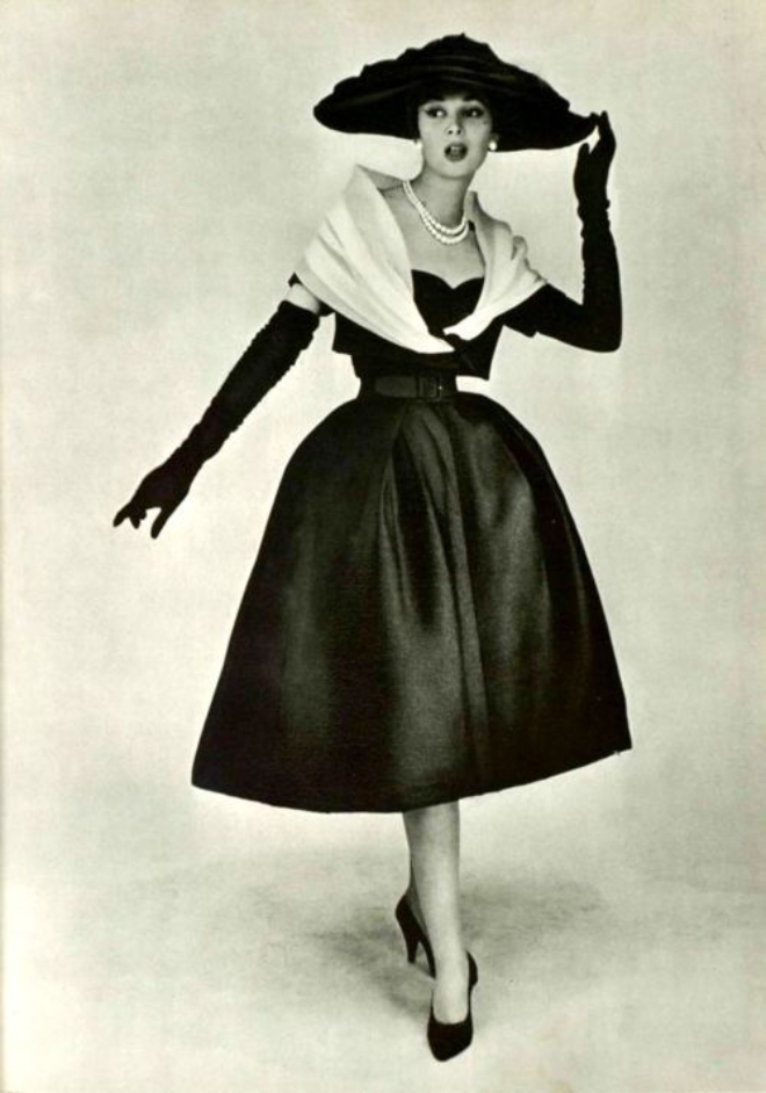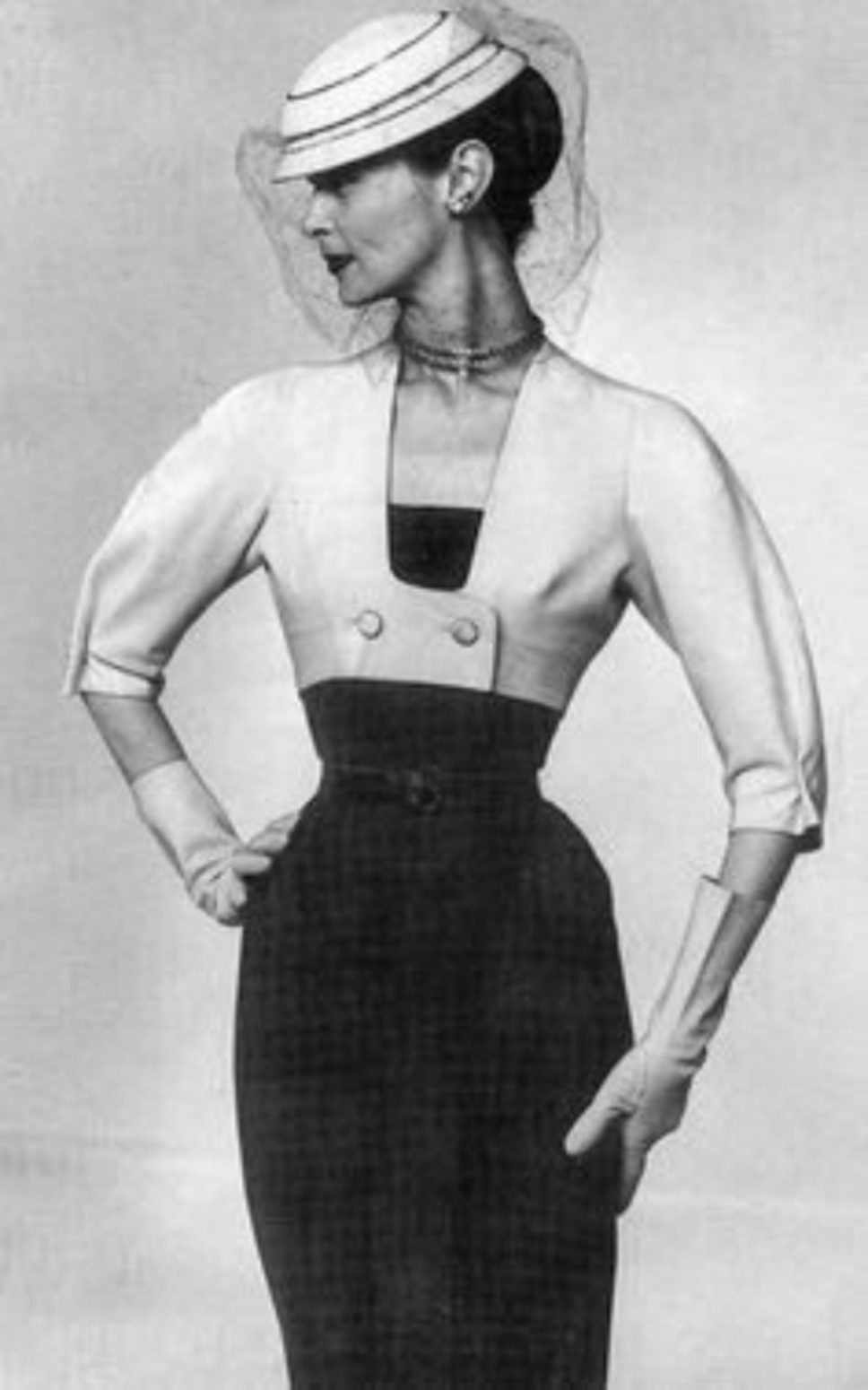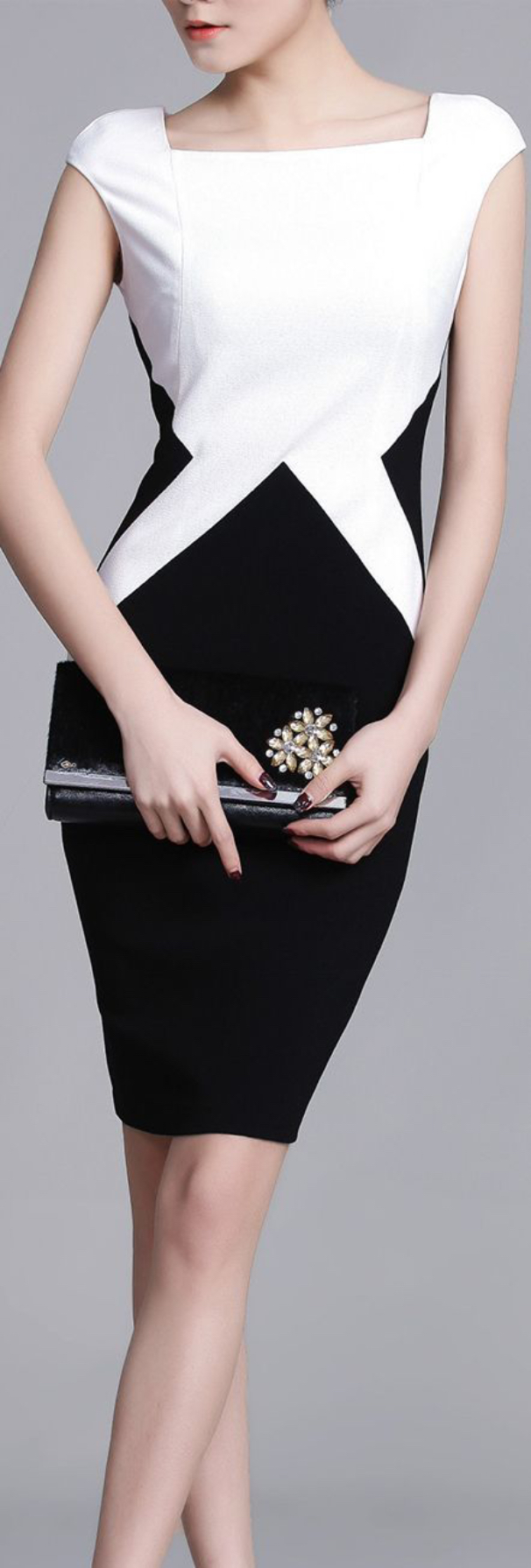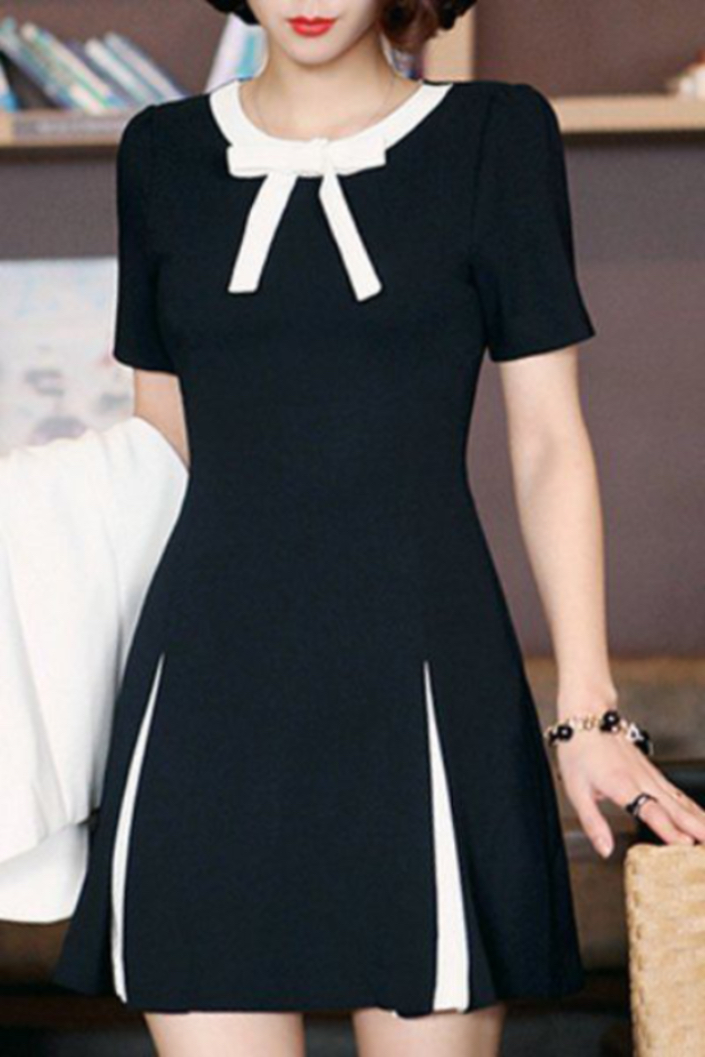Black and White Dress
Black and White Dress: this choice has long been the epitome of a stylish woman, a woman showing self confidence and passion! The Black and White Dress is not for the faint, but rather for the bold. Of course, there are numerous examples of boring garments under this description: however, the stylish woman knows how to chose the best one for herself. This page is dedicated to a discussion of the latter.
Black and White Dress: History
"In the first half of the twentieth century, domestic service was one of the main occupations for women in both France and Britain. We often imagine these women wearing black dresses, white aprons and white caps on their heads. This popular image is not too far from the reality in Britain. All those who were employed in domestic service wore a uniform regardless of the social standing of the households which employed them. Some servants wore special uniforms like cooks or lady’s maids. Most women, nevertheless, worked as maids-of-all-work for the middle and lower-middle classes and wore a print dress with a cap and a rough apron in the morning to do heavy-cleaning duties followed by a black dress and a more delicate white cap and apron in the afternoon to welcome guests and perform lighter tasks."
----------------------------------------
"At first sight, the presence or absence of a uniform may seem trivial. Clothes, however, not only offer protection from the elements, but also fundamentally define who we are and how we are perceived by others. They can indicate the wearer’s occupational and regional identity, class, gender, age and religion. They can empower and confer respectability, but they can also be used to punish, shame, ridicule and exclude."
Dr Fanny Louvier, University of Oxford


Black and White Dress: George Barbier
George Barbier (French: [ʒɔʁʒ baʁbje]), né Georges Augustin Barbier, (1882–1932) was one of the great French illustrators of the early 20th century. Born in Nantes, Franceon 16 October 1882, Barbier was 29 years old when he mounted his first exhibition in 1911 and was subsequently swept to the forefront of his profession with commissions to design theatre and ballet costumes, to illustrate books, and to produce haute couturefashion illustrations. For the next 20 years Barbier led a group from the Ecole des Beaux Arts who were nicknamed by Vogue "The Knights of the Bracelet"—a tribute to their fashionable and flamboyant mannerisms and style of dress. Included in this élite circle were Bernard Boutet de Monvel and Pierre Brissaud (both of whom were Barbier's first cousins), Paul Iribe, Georges Lepape, and Charles Martin. During his career Barbier also turned his hand to jewellery, glass and wallpaper design, wrote essays and many articles for the prestigious Gazette du bon ton. In the mid-1920s he worked with Erté to design sets and costumes for the Folies Bergère and in 1929 he wrote the introduction for Erté's acclaimed exhibition and achieved mainstream popularity through his regular appearances in L'Illustration magazine. Barbier died in 1932 at the very pinnacle of his success. He is buried in Cemetery Miséricorde, Nantes.

Black and White Dress: Art Deco Fashion
The silhouette was basically tubular throughout the period: dresses were often slightly or not at all form fitting and a waist was sometimes indistinguishable. Shorter hemlines were also appearing in women's fashion (mid calf to just above the knee). Essentially. a more boyish figure was adapted. This new appearance of women's clothing came about due to women of the time period becoming increasingly rebellious and rejecting conformity placed upon them by older generation. However, these ,masculine garments were often embellished and decorated in a lavish, feminine way. This was the first time in centuries that designers had a truly different silhouette to work with. Innovative seaming, draping gauzy fabrics, needs, and feathers were often used. In a nutshell, the glitzier, the more colourful, the crazier the print, the fluffier the feathers...the more in style you were.
Art Deco finally led to the introduction of the Flapper.

Art Deco Sportswear. 1920.


Black and White Dress: Christian Dior
On 12 February 1947 at 10.30 a.m. Christian Dior, aged 42, presented his first collection at 30 Avenue Montaigne, which was strewn with flowers by Lachaume. The Editor-in-Chief of Harper's Bazaar, Carmel Snow, strongly believed in the couturier's talent, which she had already noted in 1937 with the Café Anglais model that he designed for Robert Piguet. At the end of the fashion show, she exclaimed, "It's quite a revolution, dear Christian! Your dresses have such a new look!" A correspondent from Reuters seized upon the slogan and quickly wrote it on a note that he threw from the balcony to a courier posted on Avenue Montaigne. The news reached the United States even before the rest of France, where the press had been on strike for a month.

With his revolutionary New Look, Christian Dior wrote a new chapter in the history of fashion. Furthermore, in order to write it, he literally constructed it with his own hands. The designer had to hammer away at a Stockman mannequin that was too tough and unyielding to bear the preparatory canvases of his visionary wardrobe, says his friend Suzanna Luling: "And so, with big, nervous blows of the hammer, he gave the mannequin the same form of the ideal woman for the fashion that he was to launch." His aim was clear; his hand did not tremble. "I wanted my dresses to be 'constructed', moulded on the curves of the female body whose contours they would stylise. I accentuated the waist, the volume of the hips, emphasised the bust, In order to give my designs more hold, I had nearly all the fabrics lined with percale or taffeta, renewing a tradition that had long been abandoned." Thus, on 12 February 1947 at 10.30 a.m., the announcer introduced "numéro un, number one". The first outfit was worn by Marie-Thérese and opened the show during which the audience saw 90 different creations file past, belonging to two principal lines: En Huit and Corolle. Bettina Ballard, Fashion Editor at Vogue, had returned to New York a few months earlier after 15 years spent covering French fashion from Paris: "We have witnessed a revolution in fashion at the same time as a revolution in the way of showing fashion."

The "softness" of the New Look was deceptive; the curved jacket peplum shaped over a high, rounded, curved shoulders, and full skirt of Dior's clothes relied on an inner construction of new interlining materials to shape the silhouette. This silhouette was drastically changed from its previous more masculine, stiff, triangular shape to a much more feminine form.

Christian Dior. 1951.
Black and White Dress: 1945-1960
Throughout the post-war period, a tailored, feminine look was prized and accessories such as gloves and pearls were popular. Tailored suits had fitted jackets with peplums, usually worn with a long, narrow pencil skirt. Day dresses had fitted bodices and full skirts, with jewel or low-cut necklines or Peter Pan collars. Shirtdresses, with a shirt-like bodice, were popular, as were halter-top sundresses. Skirts were narrow or very full, held out with petticoats; poodle skirts were a brief fad. Ball gowns(full-skirted gown for white tie occasions) were longer than ankle-length dresses (called "ballerina length"), reaching the floor and worn to balls (as they are today). Cocktail dresses, "smarter than a day dress but not as formal as a dinner or evening dress" were worn for early-evening parties. Short shrugs and bolero jackets, often made to match low-cut dresses, were worn. Meanwhile, in Israel, simple Biblical sandals, blue cotton shirts and utilitarian, khaki military-inspired dress remained popular choices for many women due to ongoing economic austerity and the need to feel prepared for war.

Black and White Dress: Coco Chanel
In 1918, Chanel purchased the building at 31 rue Cambon, in one of the most fashionable districts of Paris. In 1921, she opened an early incarnation of a fashion boutique, featuring clothing, hats, and accessories, later expanded to offer jewellery and fragrances. By 1927, Chanel owned five properties on the rue Cambon, buildings numbered 23 to 31.

In the spring of 1920 (approximately May), Chanel was introduced to the Russian composer Igor Stravinskyby Sergei Diaghilev, impresario of the Ballets Russes. During the summer, Chanel discovered that the Stravinsky family sought a place to live, having left the Soviet Union after the war. She invited them to her new home, Bel Respiro, in the Paris suburb of Garches, until they could find a suitable residence. They arrived at Bel Respiro during the second week of September and remained until May 1921.Chanel also guaranteed the new (1920) Ballets Russes production of Stravinsky's Le Sacre du Printemps ('The Rite of Spring') against financial loss with an anonymous gift to Diaghilev, said to be 300,000 francs. In addition to turning out her couture collections, Chanel threw herself into designing dance costumes for the Ballets Russes. In the years 1923–1937, she collaborated on productions choreographed by Diaghilev and dancer Vaslav Nijinsky, notably Le Train bleu, a dance-opera; Orphée and Oedipe Roi.

In 1922, at the Longchamps races, Théophile Bader, founder of the Paris Galeries Lafayette, introduced Chanel to businessman Pierre Wertheimer. Bader was interested in selling Chanel No. 5 in his department store. In 1924, Chanel made an agreement with the Wertheimer brothers, Pierre and Paul, directors since 1917 of the eminent perfume and cosmetics house Bourjois. They created a corporate entity, Parfums Chanel, and the Wertheimers agreed to provide full financing for the production, marketing, and distribution of Chanel No. 5. The Wertheimers would receive seventy percent of the profits, and Théophile Bader twenty percent. For ten percent of the stock, Chanel licensed her name to Parfums Chanel and withdrew from involvement in business operations. Later, unhappy with the arrangement, Chanel worked for more than twenty years to gain full control of Parfums Chanel. She said that Pierre Wertheimer was "the bandit who screwed me."

One of Chanel's longest enduring associations was with Misia Sert, a member of the bohemian elite in Paris and wife of Spanish painter José-Maria Sert. It is said that theirs was an immediate bond of kindred souls, and Misia was attracted to Chanel by "her genius, lethal wit, sarcasm and maniacal destructiveness, which intrigued and appalled everyone". Both women were convent schooled, and maintained a friendship of shared interests and confidences. They also shared drug use. By 1935, Chanel had become a habitual drug user, injecting herself with morphine on a daily basis, a habit she maintained to the end of her life. According to Chandler Burr's The Emperor of Scent, Luca Turin related an apocryphal story in circulation that Chanel was "called Coco because she threw the most fabulous cocaine parties in Paris."
The writer Colette, who moved in the same social circles as Chanel, provided a whimsical description of Chanel at work in her atelier, which appeared in Prisons et Paradis (1932):
If every human face bears a resemblance to some animal, then Mademoiselle Chanel is a small black bull. That tuft of curly black hair, the attribute of bull-calves, falls over her brow all the way to the eyelids and dances with every maneuver of her head.

In 1931, while in Monte Carlo Chanel became acquainted with Samuel Goldwyn. She was introduced through a mutual friend, the Grand Duke Dmitri Pavlovich, cousin to the last czar of Russia, Nicolas II. Goldwyn offered Chanel a tantalizing proposition. For the sum of a million dollars (approximately US$75 million today), he would bring her to Hollywood twice a year to design costumes for his stars. Chanel accepted the offer. Accompanying her on her first trip to Hollywood was her friend, Misia Sert.
As early as 1915, Harper's Bazaar raved over Chanel's designs: "The woman who hasn't at least one Chanel is hopelessly out of fashion ... This season the name Chanel is on the lips of every buyer." Chanel's ascendancy was the official deathblow to the corseted female silhouette. The frills, fuss, and constraints endured by earlier generations of women were now passé; under her influence—gone were the "aigrettes, long hair, hobble skirts". Her design aesthetic redefined the fashionable woman in the post World War I era. The Chanel trademark look was of youthful ease, liberated physicality, and unencumbered sportive confidence.
Chanel Couture-Spring 2006.
After the jersey suit, the concept of the little black dress is often cited as a Chanel contribution to the fashion lexicon, a style still worn to this day. In 1912–1913, the actress Suzanne Orlandi was one of the first women to wear a Chanel little black dress, in velvet with a white collar. In 1920, Chanel herself vowed that, while observing an audience at the opera, she would dress all women in black.
Chanel introduced a line of jewellery that was a conceptual innovation, as her designs and materials incorporated both costume jewellery and fine gem stones. This was revolutionary in an era when jewellery was strictly categorized into either fine or costume jewellery. Her inspirations were global, often inspired by design traditions of the Orient and Egypt. Wealthy clients who did not wish to display their costly jewellery in public could wear Chanel creations to impress others.
In 1929 Chanel introduced a handbag inspired by soldier's bags. Its thin shoulder strap allowed the user to keep her hands free. Following her comeback, Chanel updated the design in February 1955, creating what would become the "2.55" (named for the date of its creation). Whilst details of the classic bag have been reworked, such as the 1980s update by Karl Lagerfeld when the clasp and lock were redesigned to incorporate the Chanel logo and leather was interlaced through the shoulder chain, the bag has retained its original basic form. In 2005, the Chanel firm released an exact replica of the original 1955 bag to commemorate the 50th anniversary of its creation.
The bag's design was informed by Chanel's convent days and her love of the sporting world. The chain used for the strap echoed the chatelaines worn by the caretakers of the orphanage where Chanel grew up, whilst the burgundy lining referenced the convent uniforms.The quilted outside was influenced by the jackets worn by jockeys, whilst at the same time enhancing the bag's shape and volume.

Chanel Ready-to-Wear, Spring 2015.
Black and White Dress: Contemporary Fashion


sammydres.com

Mugle Resort 2015

A fun version of geometry in black and white dress!
Black and White Dress: My Own Creations!
Do not expect my black and white dress versions to be Haute Couture! Far from it: they are easy-to-wear and very affordable dresses designed for all occasions. However, they are hand made in London and carry a high quality tag on them.
After all, London is The Fashion Centre par excellence!
Black and White Dress: The Beach Dress


Black and White Dress: The Bodycon Dress


Black and White Dress: The Skater Dress


Black and White Dress: In Black and White and Gray
The Cutting Edge Fashion Design Collections
Katerina Stamatelos is a fashion designer, musician (composer and pianist), painter, and poet. She holds a professional degree in fashion design and pattern making as well as five professional degrees in music (piano performance, piano pedagogy, and a PhD in music composition).
Since 2010, Katerina has been chief designer of the Sxisma Fashion House, using various online platforms to create hundreds of fashion items, including home décor. These products can be found in abundance by googling the term “Sxisma Fashion.” However, her creativity encompasses far more than these platforms would indicate. She has commented often about the simplicity of available patterns and the commonality of materials.
The publication of her visionary designs fills this void. She has accepted our representation and now feels free to design according to her wishes and take her innovative ideas as far as she is able. We could not be more pleased. The first publication is here!




